
After packing, did quite some adminstrative stuff and went out to catch a midnight movie with my friends. Chatted over the nite and went home around 5am. Time to go the airport!!
Arrived at the Budget Terminal at 6am. The place is impressive, though it's supposed to be a Budget terminal. They have a Sports Gear Shop, Times Bookstore and many other stores. The other divers - mainly instructors from Orpheus - are sleeping on the airport benches already. They just came back from another diving trip.
Travelling by Tiger btw...
Shots of the Budget Terminal from the courtesy of Jeff's blog http://www.jeffooi.com/2006/05/heres_what_singapores_budget_t.php
At 8am, our plane took off. Don't really remember what happened during the flight cos i was asleep most of the time. Around 1230pm, we landed at Clark Airport in Manilla. Boarded a mini bus and travelled to another airport to get 2 other divers who travelled by Jetstar and SIA. Took another 2 hours to reach the other airport...
Upon arriving there, learned that one flight was delayed for about 2 hours. Since there's not many things to do there, we decided to carry on sleeping.. After another hour or so, I got restless and took a few interesting shots at the carpark...
Portrait Shots of Grandma,

and her son, and her grandson...

Philippines Toilet...

Grounded Divers...

Finally, collected all the divers at around 4 pm. We started to make our way to the jetty. Another 2 hours car ride... Now, got to take a boat ride to our Dive Resort - Mermaid. It's on an offshore island.

Although it seems very dark, it's only 630pm.. Another 1 hour boat ride.. Finally we are here!!!
Pictures of the Hotel...Swimming Pool

MyRoom

Exterior of the Hotel



One commonly spotted fish in PG is the frogfish (rare fish though) It's quite easy to understand why it's called a frog fish when you have a good look at it. Below, this frog fish is spotted resting on the edge of a wreck.

Giant Frogfish

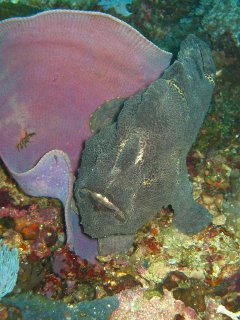
"The frogfish is superbly adapted for its habit of ambushing prey. This fish's head is mostly upturned mouth, and the small gill opening is set behind the pectoral (side) fin where its outflow of exhaled water will not reveal the fish's presence to potential prey.
The frogfish braces itself into position on the seafloor using the stubbly, jointed pectoral and pelvic (forward) fins; the fish changes position by "walking" on these hand-like fins.
The coloration of frogfishes is highly variable. Black, red, orange, yellow, and mottled patterns have been observed in a single species.
Frogfishes are among the most specialized of ambush predators; their camouflage is so effective that biologists call it "aggressive mimicry". These fish actually lure prey into ambush using a modified dorsal fin spine that acts like a "fishing pole" complete with fleshy lure. The frogfish flicks the lure over its mouth to attract small fishes. When the prey is within reach, they are literally sucked into the frogfish's cavernous mouth as the rapid expansion of the mouth cavity results in an inhalation of water. Frogfish can expand the mouth cavity to twelve times its normal resting volume within 6 to 10 milliseconds, making this one of the fastest capture mechanisms known in the animal kingdom. Because of this feeding method, frogfishes were once called anglerfishes – but this name is now reserved for families deep sea fishes that feed in much the same way." (extracted from www.triangledivers.com)
Other than those cute little "seafrogs", another rare type of fish spotted in the wrecks is the Scorpionfish.

"Scorpionfishes have large, heavily ridged and spined heads. Venomous spines on their back and fins with a groove and venom sack. Well camouflaged with tassels, warts and colored specks. Some scorpionfishes can change their color to better match their surroundings.
They feed on fishes employing a lie-in-wait strategy, remaining stationary and snapping prey that comes near. With their mouth they create a vacuum and suck prey in during a nearly imperceptible split-second movement (15 milliseconds).
Scorpionfishes are not aggressive, but if threatened they will erect their dorsal spines. If danger continues they flee, usually very fast but only for a short distance and then quickly settle back and freeze. The stonefishes for example ususally bury themselves in sand or rubble using a shoveling motion of their pectoral fins. In a matter of less than 10 seconds only the dorsal portion of the head remains exposed, some sand is thrown on top to further enhancing concealment. Some species like the devilfish have very bright red and yellow colors on the inner surface of their pectoral fins. Those colors are not visible when resting but are flashed if threatened." (extracted from http://www.starfish.ch/reef/scorpionfish.html)

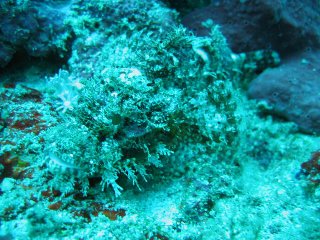
By the way, some little knowledge about the colours when diving..
Underwater light has characteristics that are quite different from the same light on land. On land, for instance, the color tones we perceive are the result of a bias in one or more of the three primary colors. Underwater, however, the deeper you go, the more most light frequencies are diffused so that at close to 40 meters, the deepest depth for recreational dives, almost all the frequencies are diffused into the water, except for blue light. This is the reason why the seas appear blue when you look at the sky from underwater. Only the blue light can penetrate that far. The first colour to be diffused is red and as you go deeper, orange.. etc. (from Canon website)
Only when you shine a white light at the object using your torch or if you are near enuff, the flash from the camera should reveal the actual colors of the fish.
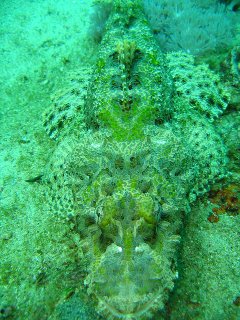
We came across this huge fish in our last day of diving. It's around 1.2m long. I'm guessing that it's a scorpion fish but not very sure... Anyway, i'm not very sure of its colors, so i just tweak the image a bit using photoshop to give it a color...
Another similar species of the Scorpion fish is the Lionfish.
The lionfish is also known as the Turkey Fish, Dragon Fish and Scorpion Fish. The lionfish are voracious predators. When they are hunting, they corner prey using their large fins and then use their lightning quick reflexes to swallow the prey whole. They are notable for their extremely long and separated spines, and have a generally striped appearance, red, brown, or black on white.
While the hardiness and disease resistance of the lionfish make their care relatively simple, the venom of the spines is extremely painful, and lionfish are recommended for only the careful aquarist.


We 've seen at least 10 lion fishes in our dives. Slow fishes but very magestic...
The infamous fishes from "Finding Nemo"


These babycat fishes are found in a crack and seemed to be posing for the camera.
"Fishes"
BoxFish


NudiBranch
"These sea slugs are soft-bodied snails. The word "nudibranch" comes from Latin nudus meaning "naked", and Greek brankhia meaning "gills". The name is appropriate since the dorids (infraclass Anthobranchia) breathe through a branchial plume of bushy extremities on their back, rather than using gills. They are carnivorous. Some feed on sponges, others on hydroids, others on bryozoans, and some are cannibals, eating other sea slugs, or, on some occasions, members of their own species.
They occur worldwide at all depths, but they reach their greatest size and variation in warm, shallow waters. Among them, you can find the most colorful creatures on earth. Because sea slugs, in the course of evolution, have lost their shell, they have had to evolve another means of defense: camouflage, through color patterns that make them invisible (cryptic behavior) or warn off predators as being distasteful or poisonous (aposematic behavior). " (extracted from Wikipedia)




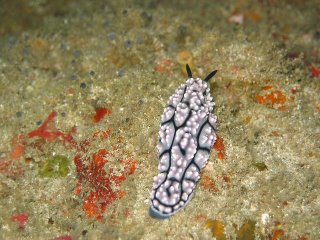
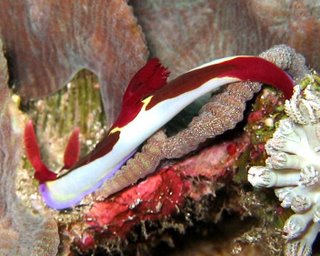
 In the picture on the left, it was taken on my last day of diving.. I got a bit restless and started playing with the nudibranches. Got one and actually stick it onto my Mask.
In the picture on the left, it was taken on my last day of diving.. I got a bit restless and started playing with the nudibranches. Got one and actually stick it onto my Mask.
Moral Eel

The moral eel is a large and elongated fish that lives in the holes and crevices of coral reefs. This eel is commonly greenish in color and can grow up to 2 meters in length. It is solitary, seldom seen and does not like to be disturbed. Although it is not poisonous, the bite of a disturbed moray eel has been known to cause serious injuries.

Mantis shrimp are marine crustaceans belonging to the order Stomatopoda. They are neither shrimps nor mantids, but receive their name purely from the physical resemblance to both the terrestrial praying mantis and the shrimp. They may grow to a length of 20–40 cm, although most species are considerably smaller. Mantis shrimp appear in a variety of colours, from rather dull browns to stunning neon.
Called "sea locusts" by ancient Assyrians, and now sometimes referred to as "thumb splitters" by modern divers - because of the relative ease the creature has in mutilating small appendages - mantis shrimp sport powerful claws, formed like jackknives, that they use to attack and kill prey by spearing, stunning or dismemberment. Some pet mantis shrimp have managed to break through their double-paned aquarium glass with a single strike from this weapon. (Wikipedia)

Food for thoughts: (Yummy!!)
In Japanese cuisine, the mantis shrimp is eaten as sashimi and as a sushi topping, and is called shako (蝦蛄). In Cantonese cuisine, the mantis shrimp is a popular dish known as "pissing shrimp" (濑尿虾, Mandarin pinyin: lài niào xiā, modern Cantonese: laaih niuh hā) due to its tendency to urinate when cooked. Because of this, mantis shrimp are speared to induce them to evacuate their bowels prior to being introduced into the cookpot. After cooking, their flesh is closer to that of lobsters than that of shrimp, and like lobsters, their shells are quite hard and require some pressure to crack.
There are health concerns associated with consuming mantis shrimp, as the shrimp is known to dwell in contaminated waters, this is especially true in Hawaii where some have grown unnaturally large and are being consumed by poorer people.

Along the dive, we spotted a octupus about 0.7 m long, hiding in one of the crack. It's one of the most interesting sea creature I've ever seen. Disturbed by us, it started to leave the crack and instantaneously changed it's colour to sand color as it settled on the sand. Realising that it has not gotten rid of the strangers, it moved to a rock and again, it does its magic trick. Within a split second, it has changed its colour into a rock. Wow!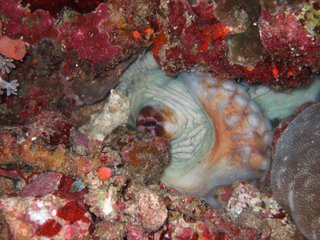
Octopuses are characterized by their eight arms (not tentacles), usually bearing suction cups. These arms are a type of muscular hydrostat. Unlike most other cephalopods, the majority of octopuses — They have almost entirely soft bodies with no internal skeleton. A beak, similar in shape to a parrot's beak, is their only hard part. This enables them to squeeze through very narrow slits between underwater rocks, which is very helpful when they are fleeing from morays or other predatory fish.
Octopuses have a relatively short life span, and some species live for as little as six months. Larger species, such as the North Pacific Giant Octopus, may live for up to five years under suitable circumstances. However, reproduction is a cause of death: males can only live for a few months after mating, and females die shortly after their eggs hatch, for they neglect to eat during the (roughly) one month period spent taking care of their unhatched eggs.
Octopuses have three hearts. Two pump blood through each of the two gills, while the third pumps blood through the body. ctopuses draw water into their mantle cavity where it passes through its gills. As mollusks, octopuses have gills that are finely divided and vascularized outgrowths of either the outer or the inner body surface.
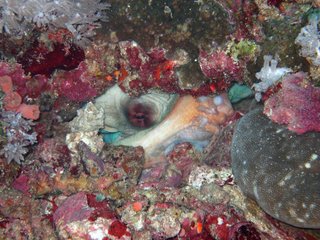
Pinnate Batfish (rare sighting)

Triggerfish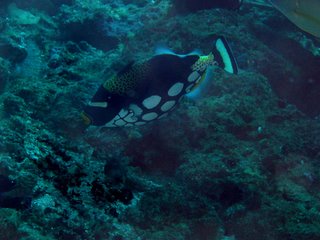
Sharks!!! We went to "Shark Cave" and there resting in the cave, is a 1.5m long shark. Woah!!
 Only a few sharks are dangerous to humans. Out of more than 360 species, only four have been involved in a significant number of fatal, unprovoked attacks on humans: the great white, tiger, oceanic whitetip and bull sharks.
Only a few sharks are dangerous to humans. Out of more than 360 species, only four have been involved in a significant number of fatal, unprovoked attacks on humans: the great white, tiger, oceanic whitetip and bull sharks.
Sharks are often killed for shark fin soup: the finning process involves capture of a live shark, the removal of the fin with a hot metal blade, and the release of the live animal back into the water. There have been cases where hundreds of de-finned sharks were swept up on local beaches without any way to convey themselves back into the sea. Conservationists have campaigned for changes in the law to make finning illegal in the U.S
So pls no more Shark fin...
Sea snakes are venomous. They have short hollow fangs near the front of the upper jaw, and the poison acts on the nervous system like the related cobra's. Unlike land snakes, however, sea snakes are not inclined to bite, and as such are not harmful unless abused. Sea Snake venom is generally more toxic and dangerous than venom from land snakes. Most cases of people being bitten by sea snakes involve fishermen bitten when sorting through a catch from a net. The venom is composed of powerful neurotoxins (affecting the nervous system) and sometimes myotoxins (affecting skeletal muscles), with a fatal dose being about 1.5 milligrams. Most sea snakes can produce 10-15 mg of venom.

Food!!!
On Top: Banana in flames.
Below: the Philippines version of Goreng Pisang
Mantis Shrimp??
Catfish??
Dive Sites in Puerto Galera
(pict loading error)
Above: the diving group : My buddy and I are missing from this photo.
.
.



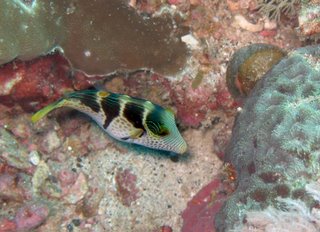



No comments:
Post a Comment